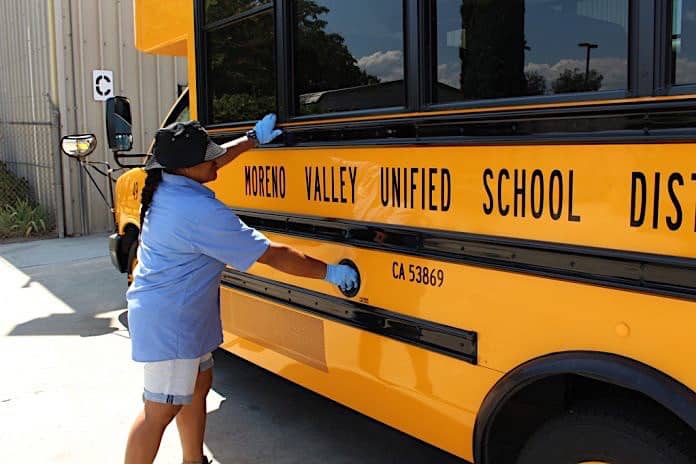Large districts like Los Angeles Unified School District frequently make the news for accomplishments such as having the nation’s largest fleet of CNG school buses, but smaller school districts in the area also have stories to tell. They have worked hard to implement alternative fuels and learned lessons along the way.
Two of these four Southern California transportation directors have diversified with both propane and CNG buses. All have installed their own CNG stations, including one under construction. Three received grant dollars to help pay for new buses, and two for infrastructure as well. Two more are eager to test all-electric school buses that send power back to the public grid — and one of them will have that opportunity this fall.
Mark Plumb, transportation manager at Torrance Unified School District, told STN the electric school bus demonstration project led by the Clinton Global Initiative (CGI) is proceeding smoothly and on time. Plumb recently attended a quarterly meeting with CGI reps at the TransPower vehicle plant in Poway near San Diego. The company, which specializes in medium- and heavy-duty electric vehicle technology, won the bid and last month began replacing the fuel tanks with battery packs and the engines with electric motors. For the conversion, Plumb said TransPower is using older Type C conventional buses from IC Bus with a 35-passenger capacity.
Six all-electric buses are set to go into service this fall at three school districts statewide. Plumb said Kings Canyon USD had to pull out of the project, so CGI is looking for a similar district to fill the slot. The other district enlisted for the pilot is Napa Valley USD, which was the first in California to deploy plug-in hybrid electric school buses.
“We will be under a lot scrutiny for the two-year trial period,” said Plumb. “There will be a myriad of data collection, most of it computerized. The National Renewable Energy Laboratory (NREL) has done a lot to track usage and research the current fleets.”
John Gonzales of the NREL, within the U.S. Department of Energy, will be a presenter at STN’s inaugural Green Bus Summit later this month, discussing how to identify the right sustainable technology for certain drive and duty cycles.
“I’m pretty excited about putting these buses in service and seeing how they do,” Plumb continued. “They are installing a new (charging) station that will be fully automated and computer controlled. Everything is cutting edge because it’s such a new concept.”
He noted that smaller fleets like his might not generate enough power to send back to the grid, however, he hopes the two e-buses will help him save on utility bills. “Once the electricity comes through, we can take power back from the buses, which helps to lower our own costs and to compensate what we’ve spent for the power to charge the buses. That’s the concept,” he said.
Savings Over Long Haul
Plumb told STN the suburban district has achieved “significant cost savings” on fuel usage since implementing compressed natural gas in 2001. Currently TUSD operates 17 Type D transit buses, five diesel and 12 CNGs, as well as nine Type A buses. “Essentially it’s been dictated by grants from the AQMD. As we retire diesels, they help us get the new CNG buses,” said Plumb, who relies on his maintenance supervisor to apply for annual grants from the Air Quality Management District. “On average, we’ve probably replaced four buses annually.”
He added that the transit-style buses are used primarily for athletic trips and extracurricular activities. Years ago the district decided to limit bus service to only those students with special needs, which amounts to about 400 passengers.
 At Moreno Valley Unified School District, located about 65 miles east of L.A., Director of Transportation Jason Songer (pictured at left) said the most important lesson he’s learned is to save taxpayer dollars whenever and wherever possible.
At Moreno Valley Unified School District, located about 65 miles east of L.A., Director of Transportation Jason Songer (pictured at left) said the most important lesson he’s learned is to save taxpayer dollars whenever and wherever possible.
“My main concern when I took over a year and a half ago was to save on anything I could, and fuel is huge for us. The average length of one route is 20 miles,” said Songer, who manages a fleet of 111 school buses, nearly half of which run on alternative fuel: 31 propane and 22 CNG buses.
“On our longer routes we try to use the CNGs, mainly for field trips and special needs,” he said. “Because of the capacity of both CNG and propane tanks, the buses can go long distances. We like to keep the older buses that are diesel in town, on shorter routes, because that saves taxpayers dollars in terms of fuel prices.”
Moreno Valley installed its own CNG fueling station on-site about six years ago and then erected a fast-fill propane station one year later. The district receives CNG from Southern California Gas, and has a five-year contract with Delta Liquid Energy for propane. The slow-fill CNG station has seven pumps that allow some drivers to fuel buses overnight, yet the rest utilize two city-run stations.
“By fueling internally and taking on the cost of a CNG station, we figured over a five-year period it would pay for itself,” said Songer, adding that the district spent nearly $400,000 on it, without any grant support. “We compared the figures, looking at $2.50 gallon outside versus maybe $1.50 or $1.24 internally.”
Allocating Precious Resources
Debbie Lajoie, director of transportation for the Pupil Transportation Cooperative, also oversees a diverse fleet composed of CNG, propane and diesel buses. The PTC was formed in 1984 when seven school districts in southeast L.A. County created a new public agency to provide school transportation services to the Whittier and Pico Rivera communities. They did it to save money because the individual operations were becoming too costly. Most of the employees came from one of the six districts, including Lajoie.
She brought 38 years of experience to the new position, along with an eagerness to try out alternative fuels like methanol, which, she said, “didn’t last long.” Then the PTC went with CNG in 1998. The co-op has had two CNG fueling stations since 1998, including a slow-fill station in its bus yard, and owns 49 CNG buses as well as five propane buses.
While grant funding partially paid for this infrastructure, she said the PTC received every single alt-fuel bus from the AQMD under the California Energy Commission Program.
“We just submitted an application for a grant from the AQMD for more CNG buses,” said Lajoie. “I did it with the help of A-Z Bus Sales. They help school districts get all the paperwork in order … registrations, titles and all the documents they need. It’s a lot of work.”
Currently the co-op pays about 50 cents a gallon for CNG and around $2.65 a gallon for propane. “I don’t have a fueling station here for propane, so that could be some of the problem. The propane company comes out and fuels them on site,” Lajoie said. “It’s more costly to do it this way, but when you’re running out of space, you have to.”
Though she appreciates the cost-savings achieved since adopting CNG especially, she pointed out that CNG repairs tend to be more expensive than traditional engine repairs, because some of the parts cost substantially more.
Plumb also observed that the savings on fuel seems to be “balanced out” by the cost of CNG repairs. “There is a lot more involvement between basic diesel versus CNG with all the components involved, safety systems and everything else that has to be watched, monitored and repaired,” he said. “My lead mechanic told me that they paid $50 to $54 each for a special platinum spark plug for the CNG buses. They’re also in the shop for minor things more than the diesels are.”
Challenges vs. Incentives
Like Torrance, Capistrano’s transportation department also uses most of its resources for special needs transportation. Director of Transportation Carlos Chicas operates the largest fleet in South Orange County, with a sizeable white fleet and 166 school buses. Thirty-one are Type D transits that run on CNG, and 21 of them are equipped with wheelchair lifts for special needs routes.
“We’ve become very aggressive since I arrived, not only with compliance but also to make sure we are as green as we can be,” said Chicas, who came aboard in March 2014. “We just applied for more funding from AQMD … Our CNG fleet is going to expand exponentially no matter what.”
Capistrano has had CNG units for quite awhile, he explained, but drivers must go off-site to fuel. Not only is that cumbersome time-wise, Chicas said it’s also pretty expensive — the off-site price is $2.54 GGE, while on-site costs $0.79 GGE. The good news is the district has broken ground on a slow-fill station that will be completed by December.
“It’s been quite an endeavor. The district has been on a challenging road for the fueling site,” he said. “Once we have our own fill station, that’s when we’re going to see significant fuel savings. Right now bus drivers spend the time to drive to fuel off-site, so we’re barely breaking even with fuel costs.”
Like Lajoie, Chicas has spent countless hours applying for grants, which he calls an “exhaustive” process. “It’s probably about 3,000 separate pages of documentation,” he continued. “We’re large but not large enough to have our own grant writers. We’re talking about a lot of money: If we’re awarded funding for the four units I just applied for, that’s in the ballpark of $8 million.”
In addition, Chicas is grateful the AQMD provides infrastructure funding to the tune of about $14,000 per unit. So, if his department is awarded for four units, this translates into about a half million.
“It really, really is a worthwhile endeavor because buses cost around $190,000 here in California. The district provides matching funds of $15,000 per unit. When you take into consideration that you’re getting $14,000 back, it’s quite the incentive to go out for grant applications,” he explained.
“Districts have a hard time maintaining a fleet replacement fund. It’s difficult. With vehicle replacement programs in California, it’s rare to find a district with money set aside for new vehicles.”
Read our related cover story in the July magazine edition on Los Angeles Unified School District leading the way in California and beyond with it’s long history of alternative fuel use.
















